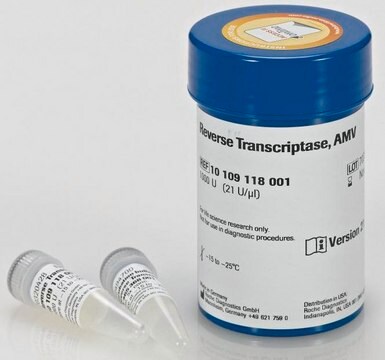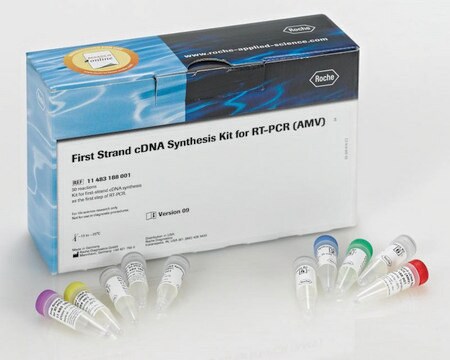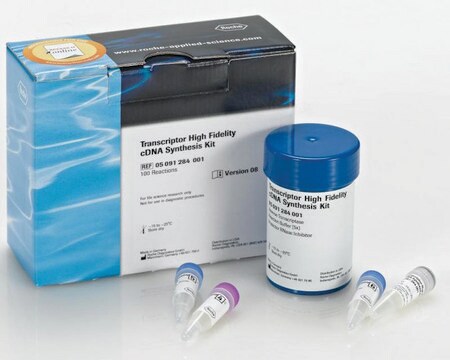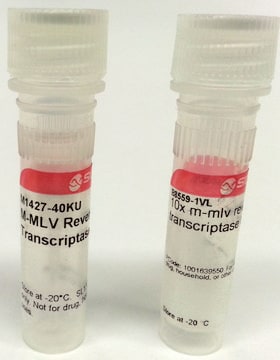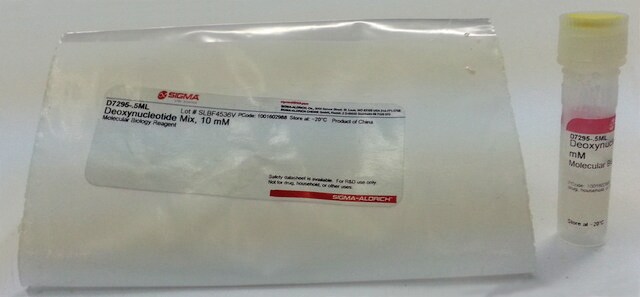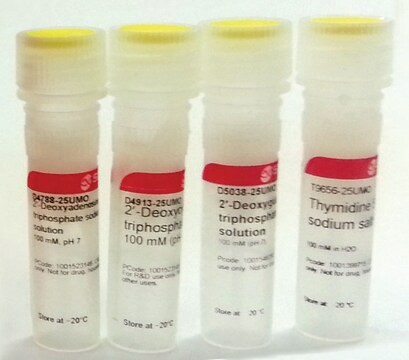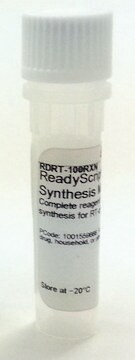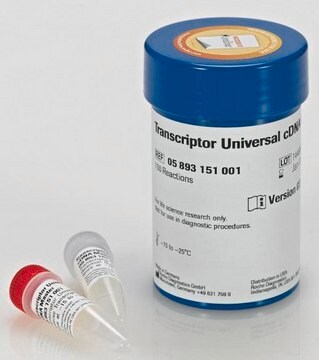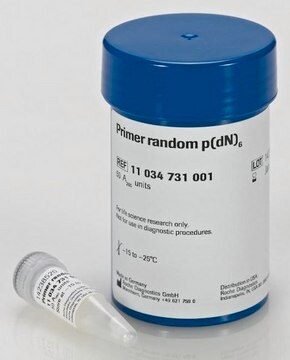Recommended Products
recombinant
expressed in E. coli
Quality Level
Assay
≥90% (SDS-PAGE)
form
liquid
usage
sufficient for 25 reactions
sufficient for 50 reactions
sufficient for 500 reactions
specific activity
0.05 U/mg
feature
dNTPs included: no
hotstart: no
manufacturer/tradename
Roche
packaging
pkg of 200 reactions (03531287001)
pkg of 25 reactions (03531317001)
pkg of 50 reactions (03531295001)
technique(s)
RT-PCR: suitable
RT-qPCR: suitable
color
colorless
pH
7.2
solubility
water: miscible
suitability
suitable for molecular biology
UniProt accession no.
application(s)
genomic analysis
life science and biopharma
detection method
probe-based
foreign activity
DNase activity, none detected
Nicking activity, none detected
RNase activity, none detected
storage temp.
−20°C (−15°C to −25°C)
General description
Application
- Synthesis of first-strand cDNA for use in subsequent amplification reactions
- RT-PCR of GC-rich RNA templates
- Cy3, Cy5, DIG, biotin, and aminoallyl labeling during cDNA synthesis
- Retrieving and cloning the 5′ and 3′ termini of mRNA by RACE
- Generation of cDNA libraries with large inserts
- Dideoxy DNA sequencing
- RNA sequencing
- 3′-end labeling of DNA fragments
- Generation of single-stranded probes for genomic footprints
- In the reverse transcription of RNA from human Papillomavirus E6, cortical and striatal tissues, muscle biopsies of Becker muscular dystrophy samples and miRNA stem-loop from oocytes and human cerebral microvascular endothelial cells (hCMVECs)
Biochem/physiol Actions
Features and Benefits
- Achieve high sensitivity in two-step RT-PCR.
- Obtain more full-length transcripts - up to 14 kb.
- Reverse transcribe difficult templates.
- Efficiently label cDNA.
Components
- Transcriptor Reverse Transcriptase, in storage buffer
- Transcriptor RT buffer, 5x concentrated
Quality
- with a conventional thermal cycler to detect a 10-kb fragment from the human dystrophin gene, starting from human skeletal muscle total RNA
- with the LightCycler® Instrument to detect 5 x 102 to 5 x 106 copies of in vitro-transcribed human PBGD RNA. The results are defined in fixed crossing points and fixed fluorescence intensity.
Preparation Note
Transcription of long, rare, or difficult RNA targets
Transcriptor Reverse Transcriptase is recommended for RT-PCR of:
- long targets, because it can transcribe up to 14 kb RNA templates
- rare targets, because it has high sensitivity
- GC-rich targets, because it can operate at high temperatures (up to +65oC) to eliminate problems associated with extensive secondary structure
Labeling for many applications
Transcriptor Reverse Transcriptase is also recommended for preparing labeled cDNA, since it accepts a wide variety of modified nucleotides (including Cy3-, Cy5-, DIG-, Biotin-, or aminoallyl-labeled dNTPs).
Reaction requirements
Transcriptor accepts ssRNA and ssDNA templates and requires a primer for transcription.
Storage and Stability
Other Notes
Legal Information
Storage Class Code
12 - Non Combustible Liquids
WGK
WGK 1
Flash Point(F)
does not flash
Flash Point(C)
does not flash
Certificates of Analysis (COA)
Search for Certificates of Analysis (COA) by entering the products Lot/Batch Number. Lot and Batch Numbers can be found on a product’s label following the words ‘Lot’ or ‘Batch’.
Already Own This Product?
Find documentation for the products that you have recently purchased in the Document Library.
Customers Also Viewed
Related Content
RT-qPCR, or quantitative reverse transcription PCR, combines the effects of reverse transcription and quantitative PCR or real-time PCR to amplify and detect specific targets. RT-qPCR has a variety of applications including quantifying gene expression levels, validating RNA interference (RNAi), and detecting pathogens such as viruses.
Our team of scientists has experience in all areas of research including Life Science, Material Science, Chemical Synthesis, Chromatography, Analytical and many others.
Contact Technical Service